"I spent most of my career sitting behind a bank desk,” writes Dale Brevik of Polson, Montana. While his office job was a good way to make a living, it wasn’t the life he wanted to make for himself. After 27 years behind one desk or another, he retired when he was only in his mid-50s. With a wealth of good years ahead of him, he had “more to do than the day is long. I retired early so that I could spend more time using my hands to construct projects, mostly with wood.”
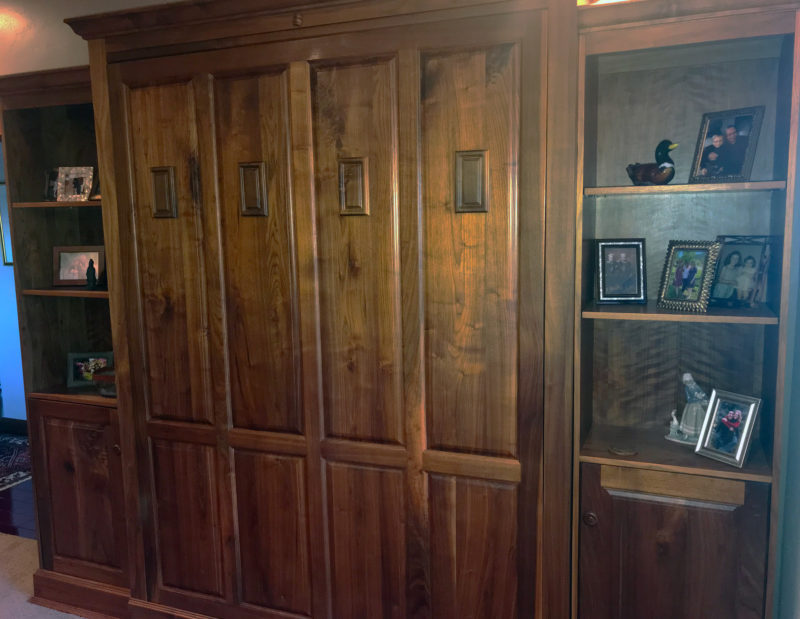 Photographs by Dale and Candyce Brevik
Photographs by Dale and Candyce BrevikHidden by Dale’s black-walnut cabinetwork is a Murphy bed.
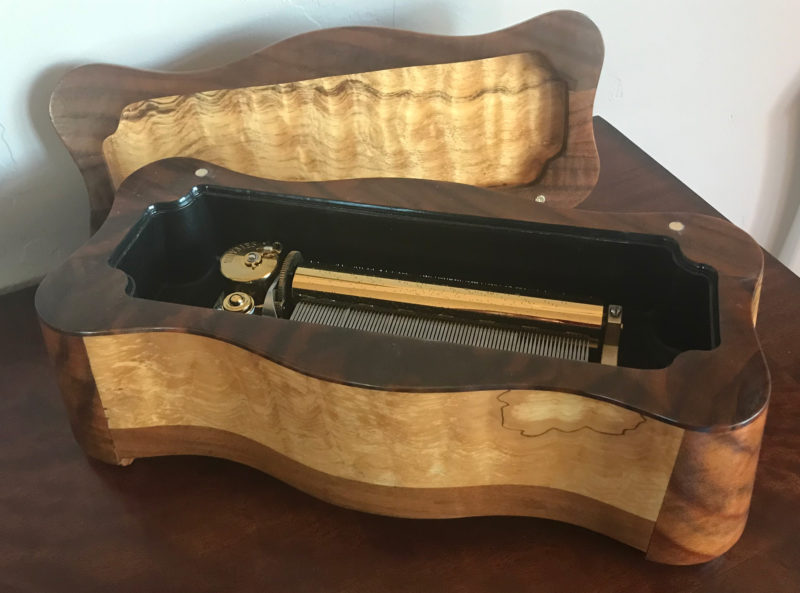
Dale used spalted curly maple and burled black walnut for one of the music boxes he made. This 72-note movement plays three Simon & Garfunkel tunes, including “The Sound of Silence.”
Dale had built many things, and retiring allowed him to follow the seductive path into the endless possibilities of working with wood. It usually begins with common lumber, straight edges, and right-angled corners—for Dale that was home construction—and leads to hardwoods, curved elements, and compound angles—like Dale’s, fine furniture, music boxes made with exotic woods and sinuous shapes. The path, for many, ultimately leads to boatbuilding with its compound curves, airtight joinery, and synthesis of beauty and utility. “Throw out your square,” Dale advises, “throw out your level and string line—boatbuilding is the ultimate woodworker’s challenge.”
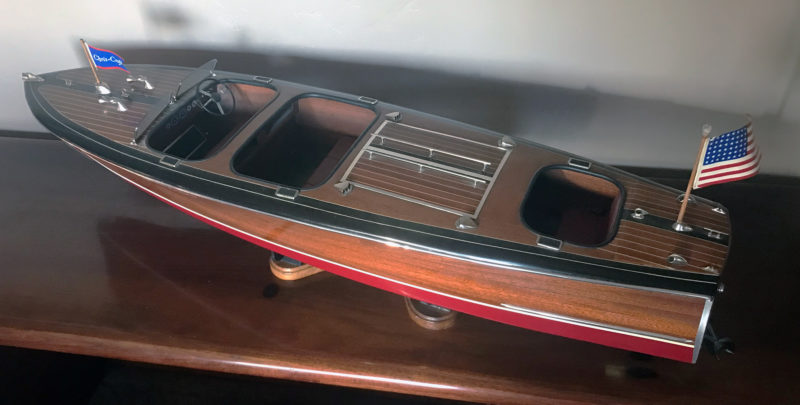
Building this model of a Chris Craft runabout inspired Dale to build the real thing.
Dale’s aspirations to build a boat took hold while he was still behind his bank desk. In 1998, he finished building a finely detailed model of a 1940s mahogany Chris-Craft triple-cockpit runabout. Working on the model inspired him to build the real thing and in 2003 he purchased plans for a Monte Carlo, Glen-L’s triple-cockpit runabout. While he waited for retirement, Dale began collecting the hardware for the boat, and found many appropriate vintage parts on eBay. Finally, three years after he retired, he began work on the runabout. The project occupied the next three years.
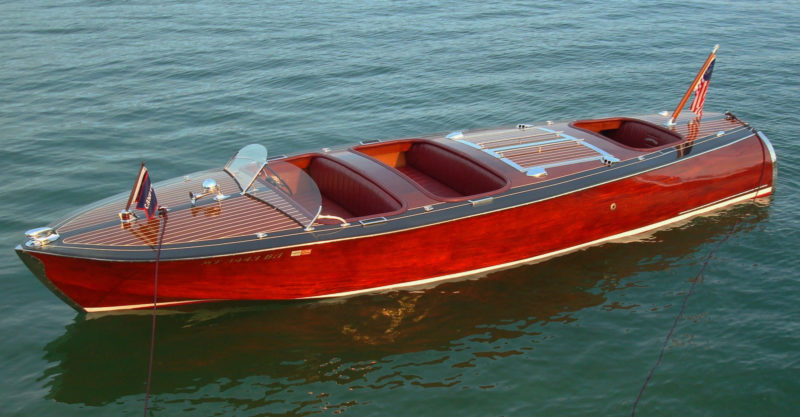
Dale spent three years building CANDYMAN, a 26′ Monte Carlo runabout designed by Glen-L.
On the Fourth of July of 2012, after being trailered down Main Street in Polson as a part of the holiday parade, the boat was launched in Flathead Lake and christened CANDYMAN—a nod to Dale’s wife, Candyce. That same day the boat was pressed into service towing water skiers.
Dale and Candyce joined the Antique and Classic Boat Society (ACBS) and CANDYMAN was a regular feature at many of the group’s gatherings. In June of 2019, at the ACBS Woody Weekend at Whitefish Lake, Dale was among a group of boaters at the lake’s lodge when Bob Moore, a chapter president, mentioned that he had never seen a jet ski made of wood. Jet skis and classic wooden boats are worlds apart and the comment could have been easily dismissed, but Dale, as a joke, said he figured he could make a wooden jet ski. A few minutes (and drinks) later, he committed himself to the project.

Dale’s project started with a 19-year-old secondhand jet ski with a seized impeller.
Dale had a lot of African mahogany left over from the CANDYMAN build. It was only 4mm thick and he decided he’d use it as an overlay on an existing jet ski. He bought one used—a 2002 Bombardier Sea-Doo GTX 4-Tec—for $1,200 (less than a tenth of what it had cost new). In its day, the GTX was a significant evolution of the type. It was powered by a 155-hp four-stroke engine that was significantly more powerful and environmentally friendly than its predecessors, which all had two-stroke engines. (Yamaha also introduced four-stroke engines to jet skis in 2002.) And while existing jet skis could only be steered by directing their water jets, which was ineffective while not under power, the GTX had a pair of spring-loaded rudders for control while coasting. In its debut, the GTX was lauded as the Watercraft of the Year by a leading personal-watercraft magazine.
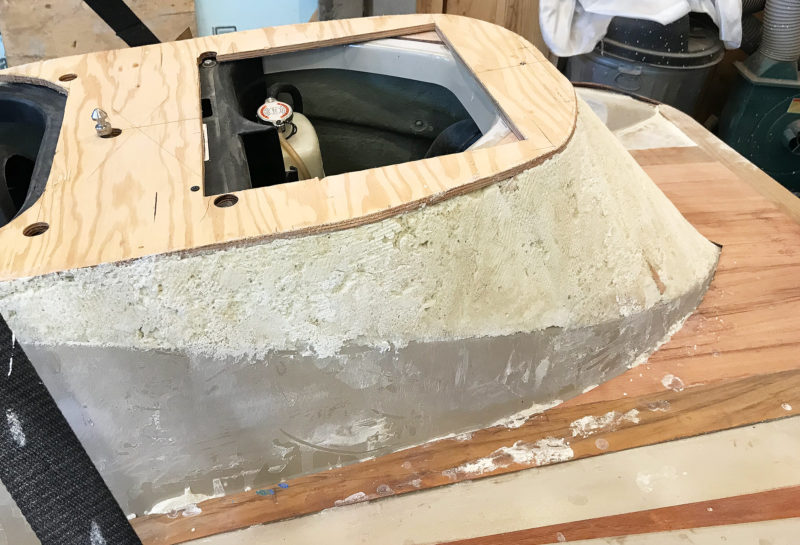
The passenger seat was cut away and would be replaced with a runabout-style engine compartment hatch. The new shape was formed with plywood, foam, and fiberglass.
The styling of the GTX deck was considered by one reviewer a “work of art. It featured precisely tailored lines and overall elegant proportions that flowed gracefully from bow to stern. That may have been the case in 2002, but Dale thought it was merely “nice looking,” and felt he could improve on it. He cut away “various humps and bumps of the Sea-Doo styling.” He sawed off the back end of the double saddle and reshaped it—and the holes and voids that were once humps and bumps—with wood, foam, and fiberglass. He eased curves to match the bending abilities of the mahogany. Work on resurfacing the jet ski went slowly.
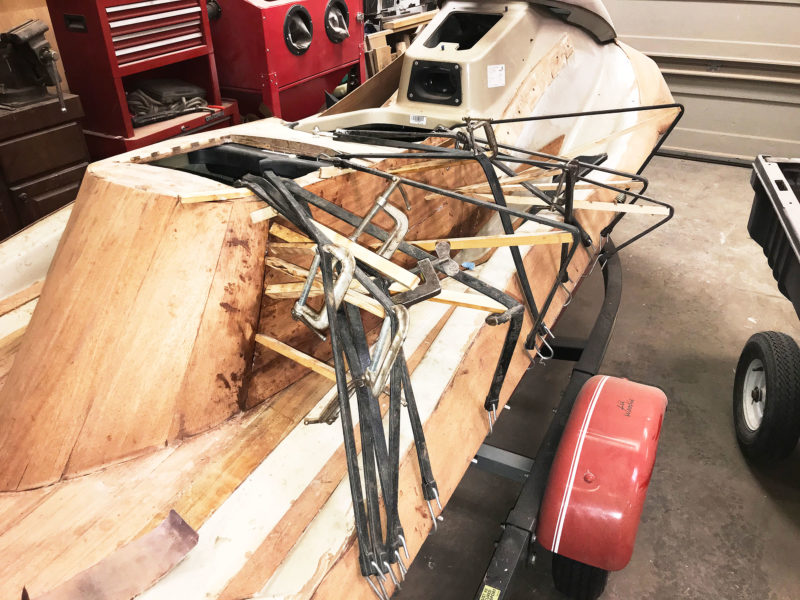
Holding the pieces of mahogany facing to the jet ski required some novel approaches. Here, rubber tie-down straps and scrap-wood struts applied pressure while the epoxy cured.
Clamping was often impossible and Dale had to figure out different ways to hold the mahogany pieces in place, in spite of the slippery epoxy, while the glue cured. He often could only glue two pieces in place in a day. In the end, there were 157 carefully shaped pieces neatly epoxied in place.
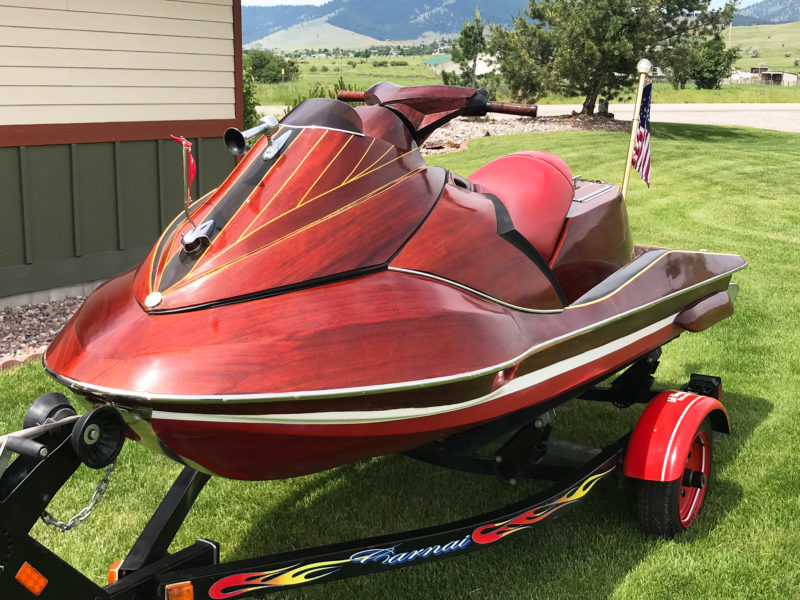
The “foredeck” has faux caulking and a king plank accentuated with ebony-black stain.
The 4mm mahogany left little room for error as Dale sanded it smooth without uncovering the fiberglass beneath it. He applied stain and 15 coats of semi-gloss varnish and sanded the cured finish first with 320-grit paper followed by 400, 600, and 800 grit. After that, it was on to 1,000- and 2,000-grit foam-disc pads, rubbing paste, and polishing compound.
The makeover included runabout-style hardware: a hinged engine hatch, faux exhaust ports, a brass flagpole topped with a classic beehive lens, and a chrome cutwater. The foredeck has a chrome airhorn, combined sidelight, and flagstaff, which carries a red pennant embroidered with the jet ski’s christened name, LIL’ WOODIE.
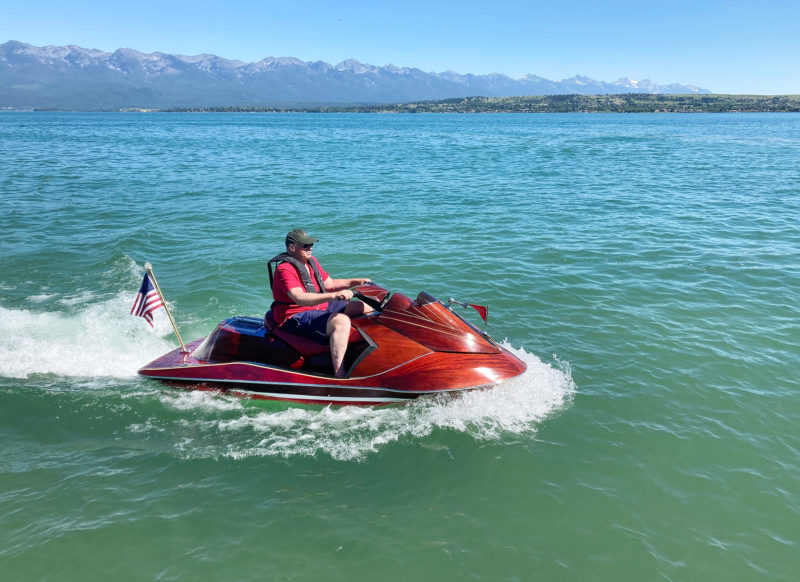
LIL’ WOODIE was a project started on a whim, and made possible Dale’s early retirement.
LIL’ WOODIE, a 19-year-old Sea-Doo turned classic mahogany beauty, is doubtless the only jet ski capable of drawing admiring looks at gatherings of the Antique and Classic Boat Society. And its metamorphosis is matched, perhaps, only by Dale’s metamorphosis from bank vice president to boatbuilder.![]()
Do you have a boat with an interesting story? Please email us. We’d like to hear about it and share it with other Small Boats Magazine readers.
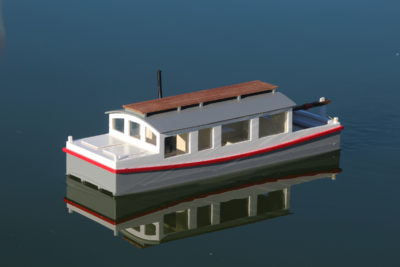
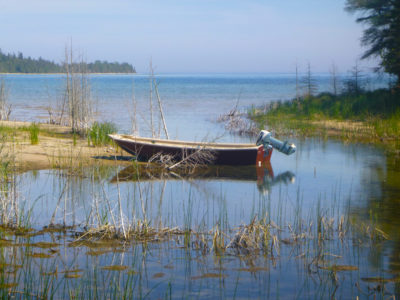
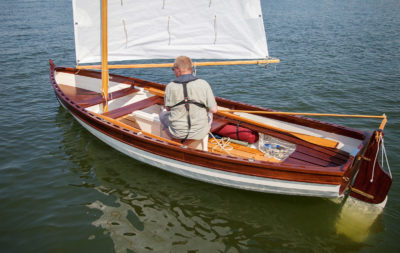
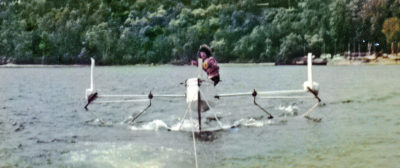
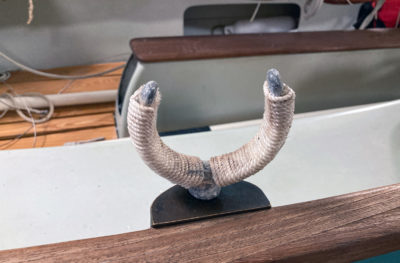
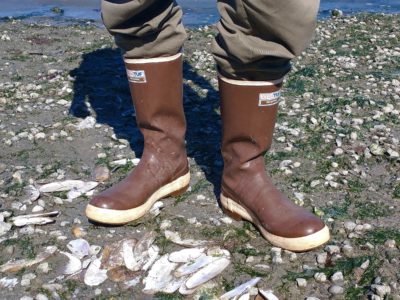
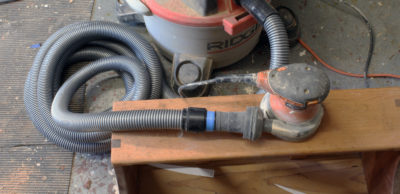
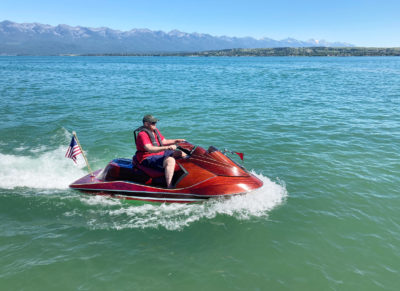
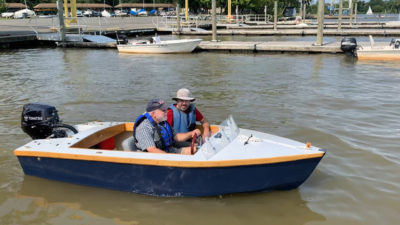
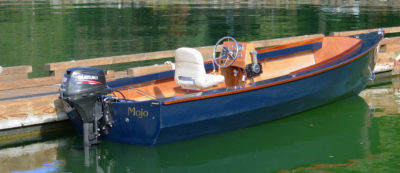

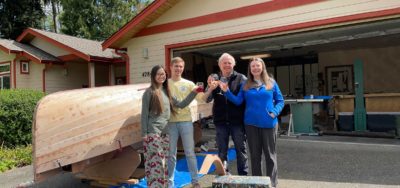
Great job on that mahogany retro-syled jet ski. Some serious head scratching it must have taken to accomplish this.
I am torn by what to do about my ’80s vintage fiberglass ski boat with V hull which suffered recent tree damage taking out 1/3 the starboard side. i think it is quite repairable. I have toyed with the idea of retro-styling it into a early wood Riva with a mahogany overlay. Fun thought though.
Anyway, congratulations. Nice to see I am not the only with crazy ideas!
Loved the novel approach to clamping using rubber bungee cords and wood sticks with actual clamps holding the bungee cord to the stick! Sort of like an archery bowstring and arrow. I might have used sheetrock screws first dipped in paste wax and then back them out after the epoxy has cured but maybe (1) that would mar the finish and (2) there were no wood cleats under the veneer to drive sheetrock screws into?
Ian Colquhoun
Kawartha Highlands, ON
There was nothing to screw to without penetrating the fiberglass and that would have been more damaging than I wanted.
All through the article, I was wondering about the weight. From the slow-ahead photo, she (it?) appears a bit heavy in the water and it seems like more weight may have been added than subtracted during the modifications. Curious about higher speed performance compared to the original…
The ski is actually somewhat lighter now than the original. I’m a big guy so I should used my attractive lightweight wife for the photo shoot? The speed has not changed, still does 55 mph.
Whenever I see a jet ski, I am reminded of a sort of rescue one fine summer’s day on Lake Perris, near Riverside, California. The unfortunate jet ski driver had experienced engine failure. Other powerboat operators either did not notice or did not care. I brought my Great Pelican wooden sailboat alongside his stranded craft and asked if he needed help. He accepted a tow back to the launch ramp from my sailboat, though he looked a bit embarrassed upon arriving back alongside the float. He was quite appreciative.
Though a lovely job was done and it’s much more attractive, sadly it’s still a jetski, which are basically the leaf blowers of the sea.